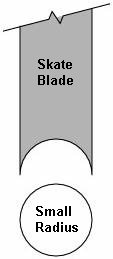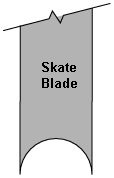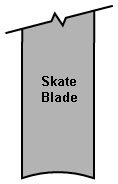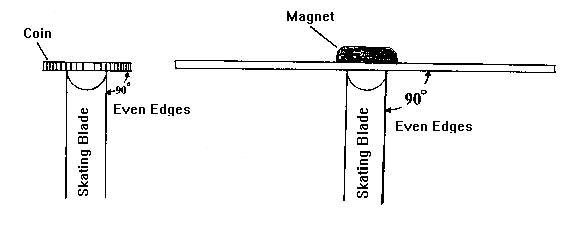 |
A SMALL RADIUS CREATES
"Deep Hollow"
- More Pronounced Tips
- Sharper Feel
- More edge
- More surface area contact
with ice
- More grip (less maneuverable)
- More drag (slower). You'll
loose glide to excess friction and be working harder.
- May have trouble stopping
without chatter or going over the top of your skates.
- Will be able to hold a very
tight turn
|
 |
 |
A LARGE RADIUS CREATES
"Shallow Hollow"
- Less Pronounced Tips
- Not so Sharp Feel
- Less edge
- Less surface area contact
with ice
- Less grip (more maneuverable)
- Less drag (faster)
|
 |
After a skate has been ground
it will have sharp edges regardless of how big or small the radius
is. Keep in mind that the long speed skating blades used
in the Olympics are honed flat with no radius. They are looking
for maximum glide. While they are careful in the turns, don't
ever doubt that these blade edges are not sharp!
The real questions are:
- "Is there enough edge
?"
- "Is there too much edge
?"
If immediately upon use a skater
claims the skate is not sharp enough, they are usually saying,
"this skate does not have enough edge on it to suit my skating".
How much edge a skater can
tolerate is affected by four main variables. These are
the skaters weight, the skaters assignment, the ice temperature,
and the skaters skill level.
Warning: in no case should a radius smaller
than 1/4" be attempted. Besides being too sharp for anyone,
this will weaken the sharpeners grinding wheel and will create
a safety hazard.
WEIGHT
An extremely light skater can
tolerate very small radii (producing a deep hollow and lots of
edge). They do not have much weight to bear on the ice.
Beginner level skaters can
learn most skills (particularly the hockey stop) easier by grinding
their skates with a very large radius. As they progress the radii
is decreased back to a normal level.
A heavy skater trying to skate
on a small radius (too much edge) will bite into the ice so hard
that they will have trouble stopping without chatter or going
over the top of their skates. They will also loose glide to excess
friction and be working harder. On the other hand, they will
be able to hold a very tight turn!
Professionals can skate on
smaller radii as they have the combination of leg/ankle strength
and talent to get away with it.
Skating on too small of a radius
feels like skating on soft ice.
While 3/8" radius edges
are more pronounced than 5/8" they are also more fragile
and less durable.
|
A "general purpose"
chart for radius by weight is as follows: |
|
VERY LIGHT |
|
AVERAGE |
HEAVY |
HOCKEY GOALIE |
|
3/8" |
1/2" |
5/8" |
3/4" |
1 TO 1 1/4" |
- A US Dime is ~11/16"
in diameter or has an ~11/32" radius. This is ~1/32"
less than a 3/8" radius.
- A US Penny is ~3/4" in
diameter or has a ~3/8" radius
- A US Nickel is ~13/16"
in diameter or has a ~13/32" radius. This is ~1/32"
greater than a 3/8" radius.
- A US Quarter is ~15/16"
in diameter or has a ~15/32" radius. This is ~1/32"
less than a 1/2" radius.
SKATERS ASSIGNMENT
Hockey:
1/2" seems to be the most common radius for kids through
high school. Forwards generally prefer smaller radius than defense
men of the same weight. Goalies generally prefer very large radius
so that they can "kick out" without catching an edge.
Figure: kids (under
60 lbs.) can skate on a 1/2" radius. A 5/8" radius
will take care of most recreational skaters.
When figure skaters get to
the level where they are in a serious program, they will be under
the guidance of a coach or instructor. The skater should consult
these people for advice on the best radius for the program they
are performing.
ICE TEMPERATURE
Most rink managers shoot for
an ice temperature of approximately 25 degrees Fahrenheit. A
temperature of 17 to 23 degrees is considered "hard hockey
ice", 25 to 26 degrees is considered good figure skate ice.
Slightly smaller radius may be used on colder/ harder ice and
vice versa.
What causes Even
and Uneven Edges
Skates needing to be sharpened
do not just have dull edges; they will also have unevenly worn
edges.
Skating: When skating aggressively, particularly
in hockey, the inside edge is worn off more than the outside.
Furthermore, the inside edge is worn mostly under the ball of
the foot and not much at all near the tail of the skate blade.
If you don’t believe this, go inline skating for a week
and don’t rotate your wheels!
Improper sharpening: If the blade is not ground
down along on the absolute middle of the skate blade it will
always have uneven edges. There are two ways this can happen.
#1 The outside edge,
which is higher, is therefore “sticking out” further
than the inside edge and must contact the grinding wheel first.
The high material will then be taken off and the grind will drop
into the center producing even edges It's the center of
the Blade that must be the guide, not the center of the worn
radius. If this rule isn't followed, you get uneven edges.
#2 Skate blades are not
all the same thickness. “Standard” (if there is any
such thing) hockey blades are .110" thick but
differences in thickness occur between different brands and even
within a brand. So the skate holder adjustments must be
verified with every sharpening and not left at some arbitrary
"standard" setting. If this rule isn't followed,
you get uneven edges.
CHECKING SKATE BLADES
FOR EVEN EDGES
Note: These drawings
are exaggerated for effect.
The oldest way to check for
even edges is to place a coin flat onto the bottom of your blade.
If your edges are even, the coin will form a 90 degree angle
to the side of the skate blade. There are two problems with this
method. The coin tends to easily fall off the blade and the coin
does not extend far enough out either side to magnify any error.
In the second drawing, we are
using a 6" flat object. We now have 3" of material
sticking out both sides to magnify any error and make it more
easily recognized.

Tip a clever measuring tool in use is a 6" long
flat piece of aluminum angle with a magnet glued to the middle.
This will hold the device in place even on stainless steel skate
blades. Or, in a pinch use a plastic credit card (or drivers
license) and hold it in place with your finger tip. You don't
need to be a rocket scientist to check for even edges!!!
ROUGHER-SHAPER
Most skates can get along without
cross grinding. However, if the skates are in poor condition,
a cross grinding may be necessary. Blades that have been beat
up by walking on concrete, are badly rusted, or have a sizable
nick/gouge, would all be candidates for cross grinding.
Cross grinding (roughing) prior
to sharpening can get the blade quickly below the problem area
and create a nice starting finish. Keep in mind that cross
grinding skates that don't need it wastes blade material.